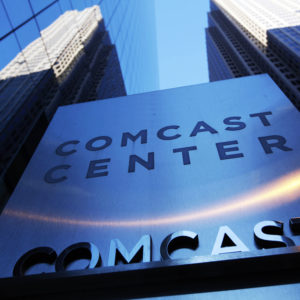Comcast submitted its argument for repealing Obama-era net neutrality rules to the Federal Communications Commission hours before the comment deadline Monday, reviving one of the least-heard yet seemingly most convincing arguments for walking back at least some of the open internet rules.
The plan pitched by FCC Chairman Ajit Pai, who voted against the rules when they were passed in 2015, seeks to repeal the FCC’s reclassification of broadband as a more-heavily regulated public utility. It also asks for comment on what to do with the three bright-line rules against web traffic blocking, throttling, and paid prioritization — the principles at the core of net neutrality.
According to cable and broadband giant Comcast, at least one of those rules threatens to seriously derail major technological innovations like self-driving cars and telemedicine.
“Comcast has never entered into any ‘paid prioritization’ agreements, and we have always made clear that we ‘do not and will not . . . discriminate against lawful content,'” the company’s Monday filing to the FCC reads. “At the same time, the commission also should bear in mind that a more flexible approach to prioritization may be warranted and may be beneficial to the public.”
Paid prioritization is the idea that internet service providers like Comcast charge internet edge providers like Netflix, which makes up as much as 30 percent of all online traffic at peak hours, more money to reach customers faster, speeding up their download times by “prioritizing” Netflix traffic over other web traffic traveling over Comcast lines. And despite the claim the nation’s largest cable provider made in its FCC filing, it entered into such an agreement with Netflix in 2014, before the net neutrality rules were passed.
“And paid prioritization may have other compelling applications in telemedicine,” the company says. “Likewise, for autonomous vehicles that may require instantaneous data transmission, black letter prohibitions on paid prioritization may actually stifle innovation instead of encouraging it.”
It isn’t the first time those arguments have been made. Nokia CEO Rajeev Suri told Mobile World Congress in 2015 “there are some services that simply require a different level of connectivity” and “differentiated quality of service,” referencing the constant, low-latency communication autonomous vehicles need to update maps in real-time.
Wireless engineer Peter Rysavy told InsideSources the same thing in September, saying a “literal interpretation of network neutrality” would mean data traveling to a car warning it’s “going to kill [a] pedestrian…have to be treated with the same priority as somebody’s YouTube or Netflix stream of Grey’s Anatomy” (it’s worth noting that while semi-autonomous driving technology like Tesla’s Autopilot — currently the most advanced commercially available system — use a wireless connection to update maps and GPS location, they rely strictly on onboard sensors like sonar, radar, and cameras to perform lane guidance and emergency braking).
“Commercial arrangements that entail prioritizing such traffic could ensure the low latency levels needed to achieve the high level of data quality necessary for such services to thrive,” Comcast lawyers argue.
What Comcast didn’t acknowledge in its filing is that the FCC already excused such services, dubbed “non-BIAS data services,” from net neutrality rules including paid prioritization in the 2015 Open Internet Order.
“We provide the following examples of services and characteristics of those services that, at this time, likely fit within the category of services that are not subject to our conduct-based rules,” the order reads. “Connectivity bundled with e-readers, heart monitors, or energy consumption sensors would also be considered other data services . . . Additional examples of non-BIAS data services may include limited-purpose devices such as automobile telematics, and services that provide schools with curriculum-approved applications and content.”
Beyond those examples, the agency said “existing facilities-based VoIP [Voice over Internet Protocol] and Internet Protocol-video offerings would be considered non-BIAS data services under our rules.”
While Comcast made no mention of the non-BIAS data services cutout passed in 2015 that seemingly provides what it asked for Monday, the company could be concerned with obtaining that permission from the FCC and overcoming regulatory red tape. The net neutrality rules go on to say “that non-BIAS data services may still be subject to enforcement action” and “that the commission will closely scrutinize offerings of non-BIAS data services and their impact on competition.”
“[I]f the commission determines that a particular service . . . is ‘[being] used to evade the protections set forth in these rules, we will take appropriate enforcement action,'” the rules state.
Comcast for its part says it has no problem with the rest of the bright-line rules.
“We do not and will not block, slow down, or discriminate against lawful content,” Comcast Senior Executive Vice President David Cohen said Monday.

